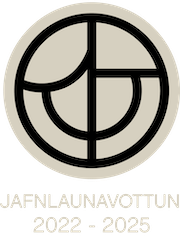Er SETDB2 MITF-háður rofi sem ræður frumuskiptingum og eiginleikum utanfrumuefnis í sortuæxlum? - verkefni lokið
Fréttatilkynning verkefnisstjóra
Sortuæxli myndast í litfrumum (e. melanocytes) húðarinnar. Sortuæxli eru einkum banvæn þegar þau meinvarpast í önnur líffæri líkamans. Það er því mikilvægt að skilja hvernig meinvarpinu er stjórnað.
Stjórnpróteinið MITF gegnir lykilhlutverki í að ákveða hvort frumur æxlisins fjölga sér eða hvort þær mynda meinvörp. Til að gera þetta þarf MITF að geta kveikt og slökkt á tilteknum genum t.d. CHD2 en MITF slekkur á því í æxlisfrumum sem fjölga sér en kveikir á því í frumum sem mynda meinvörp. Í þessu verkefni var skoðað hvernig MITF fer að þessu og í ljós kom að það gerir þetta með hjálp próteinsins SETDB2 en það er ensím sem stjórnar því hversu aðgengilegt erfðaefnið er öðrum próteinum svo sem MITF. Niðurstöður okkar sýna að MITF stjórnar framleiðslu á CDH2 með því að örva framleiðslu á SETDB2 próteininu sem síðan lokar fyrir framleiðslu á CDH2. Þegar MITF próteinið er ekki til staðar er SETDB2 ekki heldur til staðar og það leiðir þá til þess að opið er fyrir aðgengi að CDH2. Hér er því komin hugsanleg leið til að hindra meinvörp sortuæxla.
English:
Melanomas arise from the pigment producing melanocytes in the skin. Melanomas are particularly lethal when they metastasize to other organs. It is therefore important to understand how formation of metastasis is regulated. The regulatory protein MITF plays an important role in determining whether tumor cells proliferate or if they metastasize. To do this, MITF needs to be able to alternate between turning genes on or off but so far it has not been established how it does this. MITF is known to turn off the expression of CDH2 in proliferating tumour cells but on in metastasizing cells. In this project we focused on how MITF mediates this bipotent ability on CDH2 expression. We show that MITF does this by regulating the expression of SETDB2, an enzyme which regulates the accessibility of DNA. In cells which express MITF, SETDB2 closes access to CDH2 regulatory regions thus leading to lack of CDH2 expression whereas in cells where MITF is lacking, SETDB2 is not expressed, thus allowing access to CDH2 regulatory regions. This has opened new avenues for investigating how to target melanoma metastasis.
A short easily understandable description of the project, its results and impact:
This project investigated how the regulatory protein MITF determines the switch between proliferation and metastasis in melanoma cells. We showed that MITF regulates the expression of the CDH2 gene, a major contributor to cellular switch, through the chromatin modifier SETDB2. When MITF is highly expressed, SETDB2 is activated and represses CDH2 expression but when MITF is not expressed, SETDB2 is not present and CDH2 expression is allowed. This unravels a novel molecular mechanism of how metastasis is regulated in melanoma.
Information on how the results will be applied:
The project has unraveled important aspects of how MITF mediates the switch between proliferation and metastasis in melanoma cells. The results of the project will be applied in future projects to further dissect the switching process with the aim of manipulating the process and interfere with melanoma. There are two outstanding questions regarding this: First, how is the expression and activity of MITF regulated during the switch. Second, what are the regulatory regions in CDH2 that SETDB2 targets and what factors access those domains to determine effects on CDH2 expression. The aim is to answer these questions in future projects.
A list of the project's outputs:
Papers:
Ramile Dilshat, Hong Nhung Vu, Eiríkur Steingrímsson. Epigenetic regulation during melanocyte development and homeostasis. 2021. Experimental Dermatology 30(8):1033-1050. doi: 10.1111/exd.14391.
Colin Kenny, Ramile Dilshat, Hannah E. Seberg, Eric Van Otterloo, Gregory Bonde, Annika Helverson, Christopher M. Franke, Eiríkur Steingrímsson, Robert A. Cornell. TFAP2 paralogs facilitate chromatin access for MITF at pigmentation and cell proliferation genes. 2022. PLoS Genet. doi: 10.1371/journal.pgen.1010207
Juliette U. Bertrand, Eirikur Steingrimsson, Fanélie Jouenne, Brigitte Bressac-de Paillerets, Lionel Larue. Melanoma Risk and Melanocyte Biology. 2020. Acta Derm Venereol. 100(11): 5749. doi: 10.2340/00015555-3494.
Tongwu Zhang, Jiyeon Choi, Ramile Dilshat, Berglind Ósk Einarsdóttir, Michael A. Kovacs, Mai Xu, Michael Malasky, Salma Chowdhury, Kristine Jones, D. Timothy Bishop, Alisa M. Goldstein, Mark M. Iles, Maria Teresa Landi, Matthew H. Law, Jianxin Shi, Eiríkur Steingrímsson, Kevin M. Brown. Cell-type-specific meQTLs extend melanoma GWAS annotation beyond eQTLs and inform melanocyte gene-regulatory mechanisms. 2021. Am J Hum Genet. 108(9): 1631–1646. doi: 10.1016/j.ajhg.2021.06.018
Hamm M, Sohier P, Petit V, Raymond JH, Delmas V, Le Coz M, Gesbert F, Kenny C, Aktary Z, Pouteaux M, Rambow F, Sarasin A, Charoenchon N, Bellacosa A, Sanchez-Del-Campo L, Mosteo L, Lauss M, Meijer D, Steingrimsson E, Jönsson GB, Cornell RA, Davidson I, Goding CR, Larue L. BRN2 is a non-canonical melanoma tumor-suppressor. 2021. Nat Commun. 12(1):3707. doi: 10.1038/s41467-021-23973-5.
MS thesis resulting from the project:
A. Valdís Jónsdóttir. 2021. MITF as a repressor in melanoma. Master‘s thesis, School of Health Sciences, University of Iceland.
B. Eyvindur Árn Sigurðarson. 2022. The effects of Phosphorylations in MITF. Master‘s thesis, School of Health Sciences, University of Iceland.
Heiti verkefnis: Er
SETDB2 MITF-háður rofi sem ræður frumuskiptingum og eiginleikum utanfrumuefnis
í sortuæxlum?/ Is SETDB2 an MITF-dependent binary switch regulating ECM
properties and proliferation in melanoma?
Verkefnisstjóri: Eiríkur Steingrímsson, Háskóla Íslands
Tegund styrks: Verkefnisstyrkur
Styrktímabil: 2020-2022
Fjárhæð styrks kr. 55.588.000
Tilvísunarnúmer Rannís: 207067


